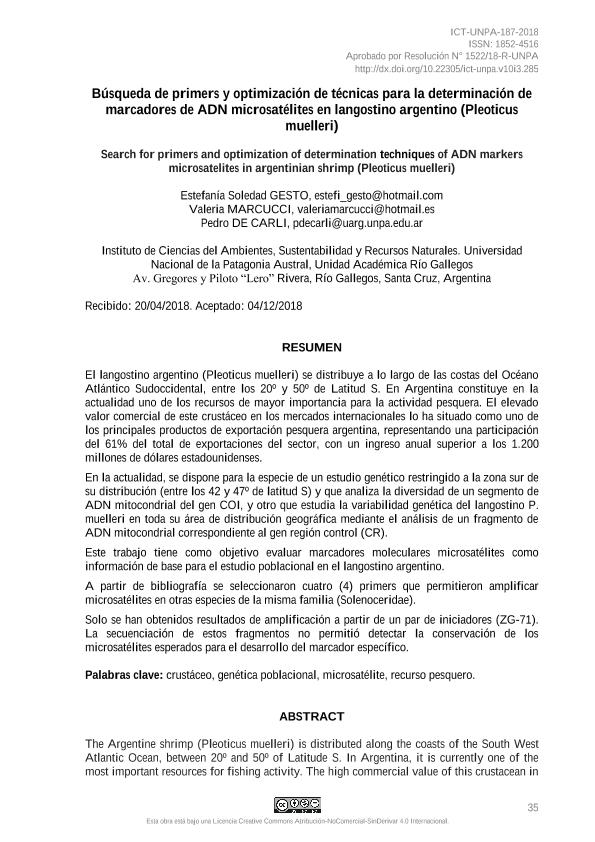Artículo
El langostino argentino (Pleoticus muelleri) se distribuye a lo largo de las costas del Océano Atlántico Sudoccidental, entre los 20º y 50º de Latitud S. En Argentina constituye en la actualidad uno de los recursos de mayor importancia para la actividad pesquera. El elevado valor comercial de este crustáceo en los mercados internacionales lo ha situado como uno de los principales productos de exportación pesquera argentina, representando una participación del 61% del total de exportaciones del sector, con un ingreso anual superior a los 1.200 millones de dólares estadounidenses. En la actualidad, se dispone para la especie de un estudio genético restringido a la zona sur de su distribución (entre los 42 y 47º de latitud S) y que analiza la diversidad de un segmento de ADN mitocondrial del gen COI, y otro que estudia la variabilidad genética del langostino P. muelleri en toda su área de distribución geográfica mediante el análisis de un fragmento de ADN mitocondrial correspondiente al gen región control (CR). Este trabajo tiene como objetivo evaluar marcadores moleculares microsatélites como información de base para el estudio poblacional en el langostino argentino. A partir de bibliografía se seleccionaron cuatro (4) primers que permitieron amplificar microsatélites en otras especies de la misma familia (Solenoceridae). Solo se han obtenidos resultados de amplificación a partir de un par de iniciadores (ZG-71). La secuenciación de estos fragmentos no permitió detectar la conservación de los microsatélites esperados para el desarrollo del marcador específico. The Argentine shrimp (Pleoticus muelleri) is distributed along the coasts of the South West Atlantic Ocean, between 20º and 50º of Latitude S. In Argentina, it is currently one of the most important resources for fishing activity. The high commercial value of this crustacean in the international markets has placed it as one of the main export products of Argentina, representing a participation of 61% of the total exports of the sector, with an annual income of more than 1,200 million US Dollars. Currently, a restricted genetic study is available for the species to the south of its distribution (between 42 and 47º latitude S) and it analyzes the diversity of a mitochondrial DNA segment of the COI gene, and another that studies the genetic variability of P. muelleri shrimp throughout its geographic range by analyzing a fragment of mitochondrial DNA corresponding to the control region (CR) gene. The objective of this work is to evaluate microsatellite molecular markers as basic information for the population study of Argentine shrimp. From the bibliography, four (4) primers were selected that allowed to amplify microsatellites in other species of the same family (Solenoceridae). Only amplification results have been obtained from a pair of primers (ZG-71). The sequencing of these fragments did not allow to detect the conservation of the microsatellites expected for the development of the specific marker.
Búsqueda de primers y optimización de técnicas para la determinación de marcadores de ADN microsatélites en langostino argentino (Pleoticus muelleri)
Título:
Search for primers and optimization of determination techniques of ADN markers microsatelites in argentinian shrimp (Pleoticus muelleri)
Fecha de publicación:
12/2018
Editorial:
Universidad Nacional de la Patagonia Austral
Revista:
Informes Científicos Técnicos
ISSN:
1852-4516
Idioma:
Español
Tipo de recurso:
Artículo publicado
Clasificación temática:
Resumen
Palabras clave:
CRUSTÁCEO
,
GENÉTICA POBLACIONAL
,
MICROSATÉLITE
,
RECURSO PESQUERO
Archivos asociados
Licencia
Identificadores
Colecciones
Articulos(SEDE CENTRAL)
Articulos de SEDE CENTRAL
Articulos de SEDE CENTRAL
Citación
Gesto, Estefania Soledad Malvina; Marcucci, Valeria Cecilia; de Carli, Pedro; Búsqueda de primers y optimización de técnicas para la determinación de marcadores de ADN microsatélites en langostino argentino (Pleoticus muelleri); Universidad Nacional de la Patagonia Austral; Informes Científicos Técnicos; 10; 3; 12-2018; 35-43
Compartir
Altmétricas




